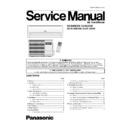Panasonic CS-E9DKDW / CU-E9DKD / CS-E12DKDW / CU-E12DKD Service Manual ▷ View online
Table (d): Indoor Air Temperature Shifting
1. Target room temperature shift value (dGetaDst)
• To offset the absolute gap between detection temperature with actual room temperature.
• The heat exchanger unit’s temperature is different based on operation mode, it become the action operation mode
• The heat exchanger unit’s temperature is different based on operation mode, it become the action operation mode
value.
Actual operation mode
Target room temperature offset value (dGetaDst)
Cooling
(1)
Heating
(2)
Dry
(0)
2. Room temperature shift value (dGeta)
• When compressor ON/OFF, correction of detected room temperature by shift value during defrost etc.
i) Initial value when operation starts, or changing the actual operation mode.
i) Initial value when operation starts, or changing the actual operation mode.
Set the offset value at each operation mode. However, in order to improve the heating start up efficiency, the offset value
will be changed based on the gap between setting temperature and room temperature.
will be changed based on the gap between setting temperature and room temperature.
Actual operation mode
Gap between setting temperature and room
temperature
Room temperature offset value
(dGeta)
Cool
—
(0)
Heat
(Operation start set temp. - room temp) <4°C
(4)
(Operation start set temp.)
4°C
(4)
Dry
—
(0)
ii) Updating during operation
During operation, it will compare with the target room temperature offset value at specific period, then the room temperature
will be updated.
will be updated.
Actual operation mode
Room temperature zone
Updating period (sec.)
Cool
—
(180)
Heat
A, B, C, D zone
(15)
Dry
—
(180)
Update the room temperature offset value (dGeta)
Temperature condition
Room temp. offset value after modified (dGeta)
Target room temp. offset value > Room temp. offset value
(dGetaDst > dGeta)
dGeta + (0.5)
Target room temp. offset value < Room temp. offset value
(dGetaDst < dGeta)
dGeta - (0.5)
Target room temp. offset value = Room temp. offset value
(dGetaDst = dGeta)
Do not change
However, if the following condition is occurred, temperature cannot detect correctly and therefore no updating will be done.
• Heating zone E and above (Temperature gap is big and great capacity increased)
• During deice
• After deice complete *within 600 sec.
• Comp stop
• During deice
• After deice complete *within 600 sec.
• Comp stop
Comp starting *within 600 sec.
17
CS-E9DKDW CU-E9DKD / CS-E12DKDW CU-E12DKD
8.1.2. Compressor Operation Frequency
8.1.2.1. The frequency determination method (Cooling operation control)
8.1.2.1.1. Basic specification
The domain directions data (intake-setting) transmitted from the interior of a room determines a changed part of frequency.
Then, a directed changed part changes frequency to the present frequency.
8.1.2.1.2. Initial frequency determination
After a starting control end, initial frequency (absolute value) is determined.
However, a FcMAX domain judges instantly.
8.1.2.1.3. Change frequency determination
When (Suction-setup) is +0.5deg, directions of Fcmax came by the mentioned initial frequency.
Fcmax continued until it reaches. (If other directions came by protection control, priority is given)
When room temperature is reached, it shifts to relative control after moving to change frequency.
The following operation determines change frequency.
The Hzkirikae = present condition frequency * Inclines and it is calculation.
Inclination = lapsed time to remote control attaintment (Minute)
Inclination
0 - 60
60 - 90
90
Inclination coefficient
80%
90%
100%
1. The present frequency is real operation frequency.
2. When change directions come out with remote control after starting, continue calculation as it is.
The time to room temperature attainment is calculated.
3. When remote control directions were changed before room temperature attainment and below room temperature attainment
temperature becomes
With initial frequency, it is considered as change frequency.
18
CS-E9DKDW CU-E9DKD / CS-E12DKDW CU-E12DKD
8.1.2.1.4. The frequency changed method
1. After shifting to relative control, (intake-setting) is every 60 seconds, A tap is adjusted according to the domain and frequency
changes relatively to present condition.
2. Intake-setting to other domains by load sudden change (remote control setting, open air introduction, etc.). When it moves, it
has the following renewal of data, an addition and subtraction tap is switched.
3. When the load change was further carried out and suction-setup separates the domain of relative control, it goes to the clause
of initial frequency and operation frequency is determined.
8.1.2.2. The frequency determination method (Heating operation control)
8.1.2.2.1. Basic specification
Intake temperature domain is sent to outdoor. Renewal of data every 60 seconds in outdoor.
Domain directions data (intake-setting) transmitted from indoor determine a changed part of frequency.
Then, a directed changed part changes frequency to the present frequency.
Change of frequency may be 1 tap = 1Hz.
19
CS-E9DKDW CU-E9DKD / CS-E12DKDW CU-E12DKD
8.1.2.2.2. Initial frequency determination
After a starting control end, initial frequency (absolute value) is determined and is immediately shift.
However, the domain of Fhmax is judged instantly.
8.1.2.2.3. Change frequency determination
When directions of Fhmax determined from mentioned initial frequency, (intake-setting) relativity control. Fhmax continued until (If
other directions came by protection control, priority is given there) room temperature is reached, it shifts to relative control after
moving to change frequency.
other directions came by protection control, priority is given there) room temperature is reached, it shifts to relative control after
moving to change frequency.
The following operation determines change frequency.
The Hzkirikae = present condition frequency *Inclines (calculation)
Inclination = Lapsed time to remote control attainment (min)
Inclination
0 - 30
30 - 60
60
Inclination coefficient
70%
90%
100%
1. The present frequency is real operation frequency.
2. When directions change come out by remote control after starting, calculation continued.
The time to room temperature attainment is calculated.
3. When remote control directions were changed before room temperature achieved and below room temperature attainment
temperature becomes
With initial frequency, it is considered as change frequency.
20
CS-E9DKDW CU-E9DKD / CS-E12DKDW CU-E12DKD
Click on the first or last page to see other CS-E9DKDW / CU-E9DKD / CS-E12DKDW / CU-E12DKD service manuals if exist.

